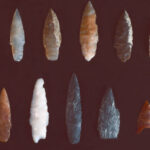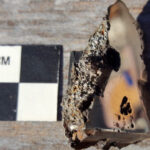The hoard was in a wooden box and contained 15 silver tetradrachma coins from the reign of Antiochos IV Epiphanes, a Hellenistic king who ruled the Seleucid Empire — which included Judea — from 175 BCE until 164 BCE.
The 2,200-year-old silver tetradrachma coins found in Israel. Image credit: Shai Halevi, Israel Antiquities Authority.
The 2,200-year-old hoard was found in Muraba’at Cave in the Darageh Stream Nature Reserve in Israel.
“When the lid was removed, it turned out that the upper part of the box was full of packed earth and small stones,” said Israel Antiquities Authority (IAA) archaeologists.
“Below this earth layer, a large piece of purple woolen cloth was found, covering the 15 silver coins that were arranged with pieces of sheep’s wool in the lower part of the box.”
The tetradrachma coins in the hoard were minted by Ptolemy VI, a Macedonian king who ruled Egypt at the same time as his uncle Antiochos IV Epiphanes reigned over the Seleucid Kingdom.
The earliest coins were minted in 176/5 BCE, and the latest was dated 171/0 BCE. The name ‘Shalmai’ in Aramaic script was secondarily incised on one of the coins.
Based on the date of the youngest coin, 170 BCE, the year when the cache was hidden can be fixed to the beginning of the Maccabean Revolt.
“It is interesting to try to visualize the person who fled to the cave and hid his personal property here intending to return to collect it,” said IAA experts Dr. Eitan Klein and Dr. Gabriela Bijovsky.
“The person was probably killed in the battles, and he did not return to collect his possessions, which awaited almost 2,200 years until we retrieved them.”
“This unique find presented the first clear archaeological evidence that the Judean Desert caves played an active role as the stage of the activities of the Jewish rebels or the fugitives in the early days of the Maccabean Revolt or the events that led up to them.”
“The Books of the Maccabees describe the dramatic events of the times that would have led people to hide their possessions in the Judean Desert until the danger passed,” Dr. Klein added.
“One explanation could be the plundering of the Jerusalem Temple treasures by Antiochos IV and the destruction of the Jerusalem city wall in the years that led up to the Hasmonean Revolt.”
“Another explanation could be the religious decrees imposed on the Jews in 167 BCE.”
“The First Book of Maccabees records that groups of Jews fled to hiding places in the desert due to the decrees imposed on the Jews:
‘Then many who were seeking righteousness and justice went down to the wilderness to dwell there: they, their sons, their wives, and their cattle because evils pressed heavily upon them.
And it was reported to the king’s officers and the troops in Jerusalem in the city of David that men who had rejected the king’s command had gone down to hiding places in the wilderness.
Many pursued and overtook them; they encamped opposite them and prepared for battle against them on the Sabbath day…. and they died, with their wives and children and cattle, about a thousand persons.’ (I Maccabees 2:29-37).”




